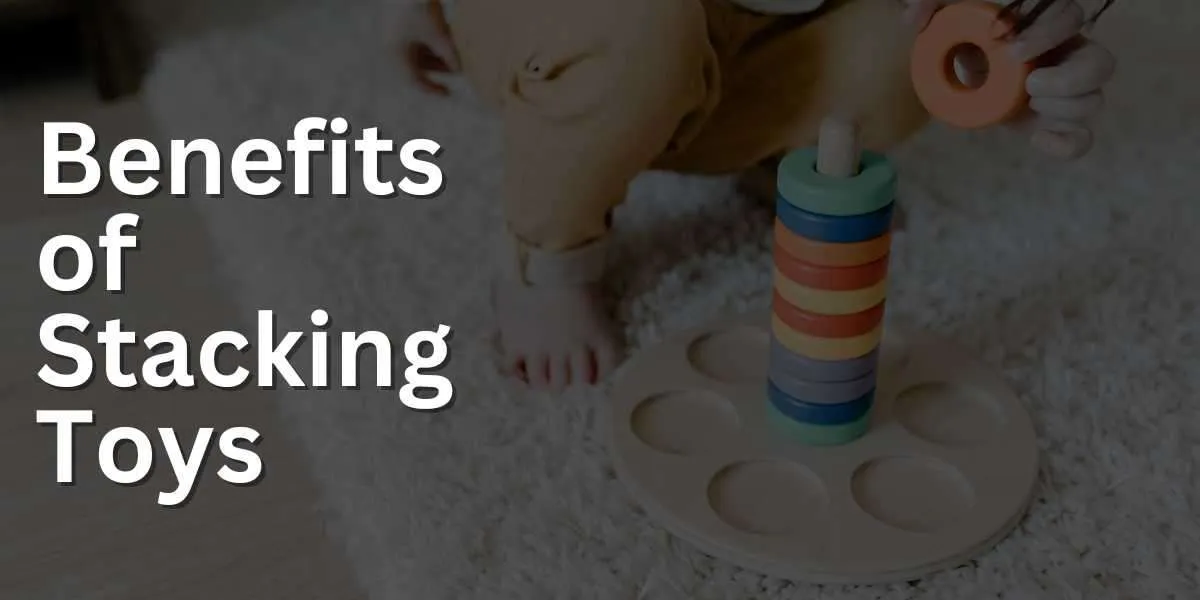Diving into the world of toddler toys and curious about the advantages of stacking toys? You’re on a valuable path. Stacking toys, while seemingly simple, are foundational tools in a child’s developmental journey, offering a many benefits that extend beyond just play.
The act of stacking, sorting, and balancing offers multi-faceted developmental advantages.
Drawing from my expertise in child development and play-based learning, I’ve constructed a comprehensive guide that unravels the myriad benefits of stacking toys for young minds.
Let’s stack our insights, layer by layer, to understand how these toys bolster motor skills, cognitive development, problem-solving abilities, and much more, setting the stage for a multitude of foundational skills.
Benefits of Stacking Toys for Cognitive Development
Baby stacking toys can help with cognitive development in several ways:
Fine motor skills
Manipulating and stacking toys require precision, refining the small muscles in a child’s hands and fingers.
Problem solving
Which piece comes next? Why does a certain configuration topple over? Stacking toys encourage critical thinking and adaptability.
Spatial Reasoning
Children learn about spatial relationships, balance, and symmetry, foundational for understanding geometry and more complex spatial concepts.
Size and shape recognition
Children can learn to recognize different sizes and shapes as they play with stacking toys, which can help with language development and mathematical concepts such as sorting and categorization.
Creativity
Beyond simple stacking, these toys become bridges, houses, tunnels, and more in imaginative play.
Hand Eye Co-ordination
Matching, aligning, and stacking pieces necessitate coordination between visual cues (seeing) and hand movements (doing).
Cognitive Flexibility
Experimenting with different stacking methods and adjusting strategies based on outcomes enhance cognitive adaptability.
Understanding Cause and Effect
Children quickly grasp that stacking without balance or support leads to a tumble, reinforcing the concept of cause and effect.
Language Development
Interactions can introduce vocabulary like “tall,” “short,” “on top,” “below,” and names of colors or shapes.
Social Skills
In group settings, children learn about sharing, taking turns, collaboration, and even conflict resolution (“I want that piece!”).
Mathematical Concepts
Counting pieces, grouping by color or size, recognizing patterns, and understanding sequences are all foundational math skills introduced by stacking.
Concentration and Patience
uilding a tower or creating a structure requires focus, patience, and persistence, especially when things don’t go as planned.
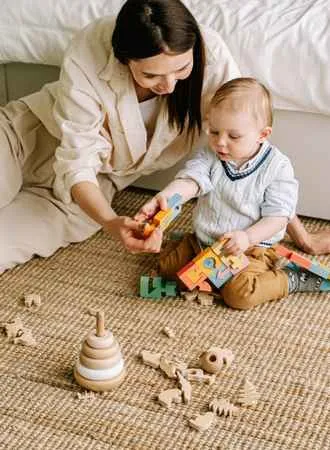
Importance of Stacking Toys in Motor Skills Development
Gross Motor Skills
Gross motor skills refer to the use of the large muscles in the body that enable us to perform activities such as crawling, walking, running, jumping, and more.
Stacking toys are a great learning tool that can help children develop their gross motor skills by allowing them to practice their trunk control and postural stability.
When children stack blocks, cardboard boxes or other toys, they need to use their core muscles to maintain their balance and stability. This, in turn, helps them develop their gross motor skills.
Fine Motor Skills
Fine motor skills refer to the use of the small muscles in the hands and fingers that enable us to perform activities such as writing, cutting with scissors, and more.
Stacking toys can help children develop their fine motor skills by allowing them to practice their intentional grasp and release.
When children stack blocks or other toys, they need to use their fingers to pick up and place each piece. This, in turn, helps them develop their fine motor skills, which are essential for tasks such as handwriting and cutting with scissors.
Hand-Eye Coordination
Hand-eye coordination refers to the ability to use the eyes and hands together to perform tasks. Stacking toys can help children develop their hand-eye coordination by allowing them to practice their eye-hand coordination.
When children stack blocks, plastic containers or other toys, they need to use their eyes to visually guide their hands to pick up and place each piece.
This, in turn, helps them develop their hand-eye coordination, which is essential for tasks such as catching a ball or playing a musical instrument.
Crossing Midline Skills
Crossing midline skills refer to the ability to use both sides of the body together in a coordinated manner.
Stacking toys can help children develop their crossing midline skills by allowing them to practice reaching across their body to pick up and place each piece.
This, in turn, helps them develop their ability to use both sides of their body together, which is essential for tasks such as reading and writing.
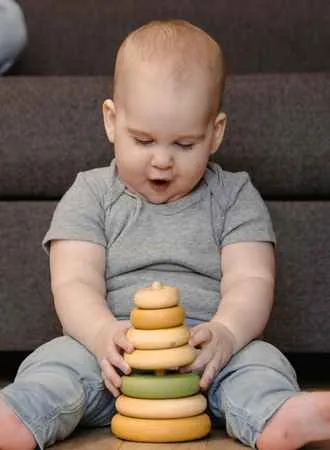
Cognitive Benefits of Stacking Toys
Enhanced Problem-Solving Abilities:
As children stack the pieces together they must think about which piece goes where in order for it all to fit together properly.
This encourages them to think critically and solve problems that arise during playtime. They teach children them how to plan ahead so that they can anticipate potential issues before they occur – developing their cognitive skills and cognitive abilities.
Will the small block fit there or does it need a large block? What happens when pouring water is put into the stacking cups with holes in the bottom? What happens when I do the various sizes in order or out of order?
Language Skills
Stacking toys can also help with language skills. As your little one stack the toys, they can learn new vocabulary words such as “balance,” “stack,” and “topple.” They can also learn to follow directions and understand spatial relationships.
Spatial Awareness
Stacking rings can help children develop spatial awareness, or the ability to understand and manipulate objects in three-dimensional space. This is because stacking rings require children to think about the size, shape, and position of the rings in relation to each other as they try to fit them together or stack them in a specific order giving them depth perception.
For example, children may need to consider the size of the rings and how they fit together in order to create a stable tower, or they may need to think about the shape of the rings and how they can be arranged to create patterns or designs. This process of visualizing and manipulating objects in three-dimensional space helps children develop spatial awareness and spatial reasoning skills.
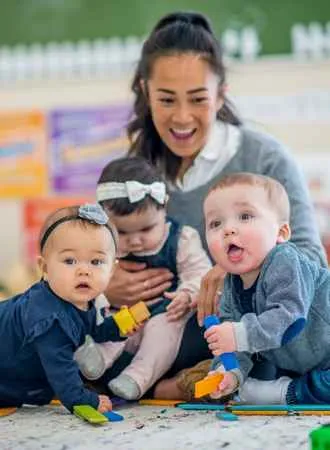
Improved Memory and Concentration:
Stacking toys require focus and attention from the child in order for them to be successful at completing each task correctly. Playing with these types of toys on a regular basis will help improve a child’s ability to remember details as well as increase their overall concentration levels when working on more complex tasks or activities later on down the road.
Understanding size and stability of pieces.
When children play with stacking toys, they learn to understand the size and stability of each piece. They learn that larger pieces should go on the bottom and smaller pieces should go on top. This helps them develop spatial awareness and an understanding of balance and stability.
Learning through trial and error.
Stacking toys provide children with an opportunity to learn through trial and error. They learn that if they stack the pieces in a certain way, the tower will fall. If they stack the pieces in a different way, the tower will stay up. This helps them develop problem-solving skills and learn from their mistakes.
Grasping the concept of cause and effect.
Stacking toys also help children grasp the concept of cause and effect. They learn that if they stack the pieces in a certain way, the tower will fall. They learn that if they stack the pieces in a different way, the tower will stay up. This helps them understand that their actions have consequences and helps them develop critical thinking skills.
Shape Identification and Colour Recognition
Through the use of stacking cups and building blocks, little children can learn important visual perception skills such as shape recognition and color identification. By stacking different shapes and sizes of blocks, your child can learn to recognize and differentiate between different shapes. As they stack the blocks, they can also learn about spatial awareness and how objects fit together.
Stacking toys can also help with color identification. See if you can find a stacking toy where each individual block has its own color, shape, or size. This will help your child learn to differentiate between different colors and associate them with different objects.
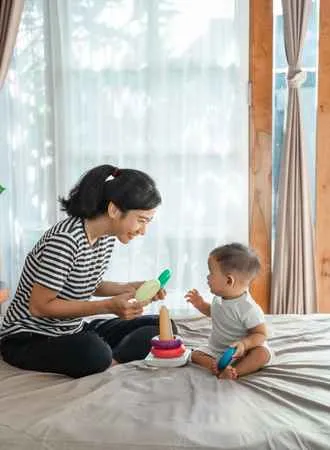
How Do Stacking Ring Toys Help Develop Skills?
If you have a baby or toddler at home, odds are you have a stacking ring toy. It’s a great toy with numerous advantages, and it’s such a good decision to have one at home for your child to play with while she is still in her early developmental stages.
These wooden made toys energize critical thinking, help develop hand-eye coordination and fine motor skills as well as teach basic numeracy, logic and colour recognition. There are a few things to keep in mind if we want to motivate our children to develop their skills at an early age through play.
At 8 – 9 months, you want your baby to practice using her hands and fingers to manipulate objects around her. This is where stacking ring toys come in handy. These toys have such exceptional developmental value that they not only entertain your children but also encourage hand and arm movements.
Not only that, most toys are brightly coloured and come in a wide range of shapes and forms.
These are simple toys yet our little children cannot get enough of them. These are iconic toys that are pretty straightforward.
There is a post, and rings of differing sizes, and your baby stacks these rings on top of each other utilizing the post. Babies and toddlers absolutely love these toys and it is very difficult not to see why.
Hand-Eye Coordination & Fine Motor Skills
These baby toys help children learn how to control their hands and fingers to hold and manipulate objects. Newborns do not yet possess the ability to control the muscles of their hands and fingers so they use their entire hands to explore and hold objects. This is the reason why some stacking toys have huge chunky rings. Babies who have yet to develop fine motor skills can easily hold on to these rings and play with them.
Being able to stack objects on top of each other is a good indication that your kid has developed her fine motor skills and hand-eye coordination. Hand-eye coordination is the controlled movements of the eyes in coordination with the hands and fingers. This is an essential skill that your child needs to develop to perform simple actions like using a pair of scissors. Moving on from simple stacking toys or activity cubes is an ideal development for toddlers.
Colour & Shape Recognition
Most toys come in bright colours. These toys will definitely catch your child attention and entertain her for hours. You can use these toys to teach her first colours and numbers.
Our world is made up of colours and shapes. It is important to develop colour recognition and numeracy before your child starts going to school.
Problem Solving & Cognitive Skills
These toys appear simple to us adults but they pose a challenge for our little ones to figure out. When your child starts playing with rings, she might be thinking about how she can stack the rings on top of each other.
Encouraging them to figure things out helps build confidence as well as providing a risk-free playing environment for our children to experiment with solutions.
FAQs in Relation to Stacking Toys Developmental Benefits
What do children learn from stacking?
Stacking toys or wooden blocks provide children with a range of benefits. These seemingly simple toys helps them develop fine motor skills, develop hand eye coordination and problem solving abilities. It encourages creativity as they explore different ways to stack the blocks or rings.
Stacking also teaches patience and perseverance as children work to build their towers higher and higher. Finally, stacking can help kids learn about spatial relationships such as size, shape and balance which are important for future math concepts like geometry.
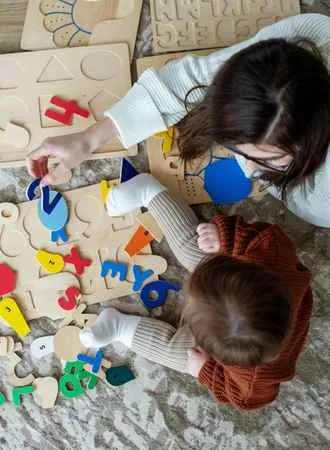
What type of development is stacking blocks?
Stacking blocks is a type of development that encourages children to use their fine motor skills and hand-eye coordination. It helps them learn about size, shape, balance, and spatial relationships. Stacking blocks also allows for creative play as children can create towers or other structures with the pieces.
This type of activity can help build problem solving skills as well as teach basic math concepts such as counting and sorting. Stacking blocks provides an opportunity for social interaction between peers or adults in the form of cooperative play or friendly competition.


